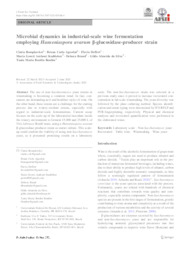Microbial dynamics in industrial-scale wine fermentation employing Hanseniaspora uvarum b-glucosidase-producer strain.
Microbial dynamics in industrial-scale wine fermentation employing Hanseniaspora uvarum b-glucosidase-producer strain.
Author(s): ROMPKOVKS, C.; AGUSTINI, B. C.; DEFFERT, F.; STADTLOBER, M. G. A.; BRAND, D.; SILVA, G. A. da; BONFIM, T. M. B.
Summary: The use of non-Saccharomyces yeast strains in winemaking is becoming a common trend. In fact, consumers are demanding new and healthier styles of wine. On the other hand, these strains are a challenge for the starting process due to winery-resident strains, especially with regard to industrial-scale fermentations. Current assay focuses on the scale-up of the laboratorial inoculum inside the winery environment to ferment 15,000 and 25,000 L of Vitis labrusca Bordo? must, using a Hanseniaspora uvarum b-glucosidase-producer strain as starter culture. This scaleup could confirm the viability of using non-Saccharomyces yeast, as it presented promising results on a laboratory scale. The non-Saccharomyces strain was selected in a previous study since it proved to increase resveratrol concentration in lab scale winemaking. The yeast diversity was followed by the plate culturing method. Species identification and strain typing were determined by ITS-RFLP and PCR-fingerprinting, respectively. Physical and chemical analyses and resveratrol quantification were performed in the elaborated wines.
Publication year: 2021
Types of publication: Journal article
Unit: Embrapa Grape & Wine
Keywords: Laboratory scale, Non-Saccharomyces yeast, Resveratrol, Table wine, Wine yeast, Winemaking
Observation
Some of Embrapa's publications are published as ePub files. To read them, use or download one of the following free software options to your computer or mobile device. Android: Google Play Books; IOS: iBooks; Windows and Linux: Calibre.
Access other publications
Access the Agricultural Research Database (BDPA) to consult Embrapa's full library collection and records.
Visit Embrapa Bookstore to purchase books and other publications sold by Embrapa.

